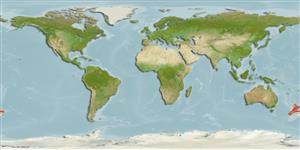ກຸ່ມປາກະດູກອ່ອນ (ເຊັ່ນ: ປາສະຫລາມ, ປາຜາໄລ) (sharks and rays) >
Carcharhiniformes (Ground sharks) >
Triakidae (Houndsharks) > Triakinae
Etymology: Mustelus: Latin for weasel, an ancient name for sharks, possibly referring to the pointed snouts, swift movements and/or rapacious feeding behavior of smaller predatory sharks [strictly not tautonymous with Squalus mustelus Linnaeus 1758 since type was designated by the ICZN] (See ETYFish); lenticulatus: Latin for freckled, referring to peppering of white spots on upper sides (See ETYFish).
Environment: milieu / climate zone / ລະດັບຄວາມເລິກ / distribution range
ນິເວດວິທະຍາ
ສັດທະເລ ອາໄສຢູ່ໃກ້ໜ້າດິນໃຕ້ພື້ນທ້ອງນ້ຳ; ປາທີ່ມີການເຄື່ອນຍ້າຍໃນສະເພາະມາະຫາສະມຸດ (Ref. 54100); ລະດັບຄວາມເລິກ 0 - 860 m (Ref. 26346), usually 0 - 400 m (Ref. 89422). Subtropical; 34°S - 48°S
Southwest Pacific: Kermadec Islands (Ref. 8879) and New Zealand; reported from southern Australia (Ref. 9258).
Length at first maturity / ຂະໜາດ / ນ້ຳໜັກ / Age
ການຈະເລີນເຕັມໄວ: Lm 90.9, range 79 - 100 cm
Max length : 125 cm TL ຕົວຜູ້/ບໍ່ມີເພດ; (Ref. 9072); 151.0 cm TL (female); common length : 85.0 cm TL ຕົວຜູ້/ບໍ່ມີເພດ; (Ref. 9258)
Found on the insular shelves, often close inshore (Ref. 244). Feeds on crustaceans, especially crabs (Ref. 244). Ovoviviparous (Ref. 50449). Makes seasonal inshore-offshore movements (Ref. 244). Makes extensive coastal migrations, with one tagged female moving at least 1160 km (Ref. 54100). Forms schools separated by size and sex (Ref. 244). Utilized fresh for human consumption (Ref. 244).
Ovoviviparous, embryos feed solely on yolk (Ref. 50449). With 2 to 37 young born at 20-32 cm (Ref. 26346).
Compagno, L.J.V., 1984. FAO Species Catalogue. Vol. 4. Sharks of the world. An annotated and illustrated catalogue of shark species known to date. Part 2 - Carcharhiniformes. FAO Fish. Synop. 125(4/2):251-655. Rome: FAO. (Ref. 244)
IUCN Red List Status (Ref. 130435: Version 2025-1)
Threat to humans
Harmless
Human uses
ການປະມົງ: ເປັນສີນຄ້າ; ຊະນິດປາທີ່ຖືກນຳໃຊ້ເຂົ້າໃນການຫາເພື່ອເປັນເກມກິລາ: ແມ່ນ
ເຄື່ອງມື
Special reports
Download XML
ແຫຼ່ງອີນເຕີເນັດ
Estimates based on models
Preferred temperature (ເອກະສານອ້າງອີງ
123201): 8.6 - 18.3, mean 13.7 °C (based on 370 cells).
Phylogenetic diversity index (ເອກະສານອ້າງອີງ
82804): PD
50 = 0.5000 [Uniqueness, from 0.5 = low to 2.0 = high].
Bayesian length-weight: a=0.00186 (0.00108 - 0.00321), b=3.14 (2.99 - 3.29), in cm total length, based on LWR estimates for this species & Genus-body shape (Ref.
93245).
ຊັ້ນເຂດຮ້ອນ (ເອກະສານອ້າງອີງ
69278): 3.5 ±0.3 se; based on diet studies.
Generation time: 10.0 ( na - na) years. Estimated as median ln(3)/K based on 2
growth studies.
ຄວາມຢືດຢຸ່ນ (ເອກະສານອ້າງອີງ
120179): ຕຳ່, ປະຊາກອນຕຳ່ສຸດທີ່ໃຊ້ເວລາສອງເທົ່າ 4.5 - 14 ປີ (tmax=12+; K=0.11-0.16; tm=3-4; Fec=2-23).
Fishing Vulnerability (Ref.
59153): Very high vulnerability (77 of 100).
🛈
Climate Vulnerability (Ref.
125649): Very high vulnerability (77 of 100).
🛈
Nutrients (Ref.
124155): Calcium = 15.1 [4.6, 75.0] mg/100g; Iron = 0.449 [0.142, 1.704] mg/100g; Protein = 21.5 [19.2, 23.7] %; Omega3 = 0.149 [0.062, 0.352] g/100g; Selenium = 53.5 [16.3, 197.5] μg/100g; VitaminA = 6.83 [2.27, 20.29] μg/100g; Zinc = 0.619 [0.272, 1.268] mg/100g (wet weight); based on
nutrient studies.
